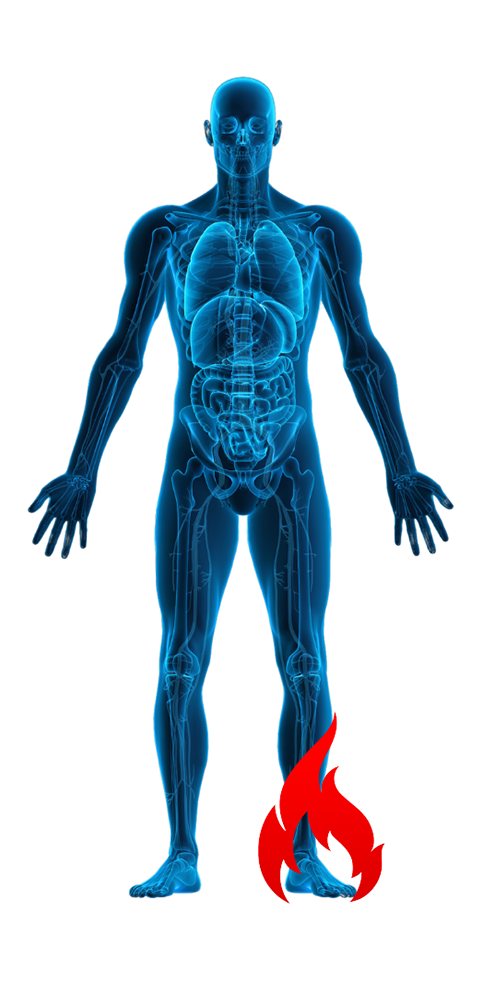Conditions:
Complex Regional Pain Syndrome (CRPS)
Complex Regional Pain Syndrome (CRPS): A Rare Disorder
Complex Regional Pain Syndrome affects nearly 200,000 people in the United States each year, roughly around one in every 1,700 US adults. It is a rare disorder, ranked amongst the most painful of all medical illnesses. To your surprise, Complex Regional Pain Syndrome is also nicknamed ‘suicide disease’ as it has no cure and indeed limited treatments.
The pain is severe, persistent, and perplexing, and it can be misdiagnosed or misunderstood as chronic pain. So, if you or someone you know develops intense pain lasting for over six months due to the aftermath of trauma or injury, seek medical help ASAP.

What is CRPS?
Complex Regional Pain Syndrome (CRPS), also called Reflex Sympathetic Dystrophy (RSD), is a chronic ailment leading to persistent pain, burning sensation, and swelling in your arms, hands, legs, and feet (usually a single limb).
Typically, your body’s response to injuries begins when pain receptors convey pain messages to your brain in the form of nerve impulses. Upon reaching the pain centers of your brain, these generate new signals for the area of injury sent via the sympathetic system. The sympathetic impulse is responsible for triggering an inflammatory response that causes the blood vessels to expand and redness in the injury site. As your wound heals, the inflammation and pain subside.
But with CRPS, your pain, swelling, or redness doesn’t decrease even after the wounds heal. The injury can be major or something very insignificant. Moreover, the CRPS symptoms can worsen over time as the discomfort affects a much wider area than the original injury site and continues long after the injury heals. The causes remain unexplained; however, it is known that abnormal impulses keep traveling along the nerves stimulating the inflammatory response continuously.
CRPS Causes
The exact causes aren’t clear. CRPS often results from an injury, where the wound doesn’t have to be something life-threatening. It can result from a fracture, bruise, burn, or sprain. Moreover, a dental infection, bunion surgery, car accident, being hit by an object, or something as ordinary as stress (non-painful event) also triggers CRPS. It is just an abnormal neurological response (overreaction to an injury), and not everyone with similar injuries would experience CRPS.
CRPS Types
Usually, there are two types of CRPS categories: Type 1 CRPS and Type 2 CRPS – the difference lies in whether or not any nerve damage is involved.
Type 1 CRPS, previously known as the RSD disease, shows no evidence of nerve damage. If you are diagnosed with CRPS, it is probably this one. However, type 2 CRPS, previously called causalgia, shows evidence of nerve damage.
Regardless of the type you are diagnosed with, CRPS treatment remains the same. The condition may be more common in women and can occur at any age but peaks between the age of 40 and 70.
CRPS Stages
CRPS is a real, life-altering condition that can impact your life immensely. Intense pain, worsening over time, and usually spreading to other areas of the body are common CRPS/ RSD symptoms. The condition progresses in stages, and here is what you must know:
Stage 1
This phase lasts from a month to three months, causing severe burning, skin changes, muscle spasms, tremors/ jerks, joint stiffness, and sensitivity to touch.
Stage 2
This stage can last for about six months, and the CRPS symptoms progress rapidly. Stiff joints, intense pain, changes in nails/ hair/ skin, and uneasiness spreading to unaffected limbs are a few stage 2 CRPS symptoms.
Stage 3
This is the chronic phase where discomforts increase enormously. Severe CRPS develops after a year of experiencing CRPS symptoms. Your condition can last for another few years, and if not treated, it might get permanent. Pain can be perpetual, and you can lose mobility and function.
Battling CRPS
Battling Complex Regional Pain Syndrome is like fighting for your life. CRPS diagnoses and CRPS treatment is complex but not impossible. Several newer studies showing the brain’s involvement in processing pain destigmatizes CRPS, which was earlier suggested as just chronic pain or something psychological.
When you contact a Renovaire Pain Care specialist, we look at your bone scans, skin tests, MRIs, nerve conduction tests, etc., to work up the necessary care and treatment tailored to your needs. We also check for other health concerns, including arthritis, clotted veins, and muscle diseases. Although CRPS pain is permanent, early treatment can reduce the symptoms significantly.
Helping patients cope with their condition and live an easy life is our ultimate goal. With physical therapies, medications, self-care, and lifestyle changes, you can battle CRPS head-on. The aim is to slow the condition’s progression and keep your physical and emotional tensions at bay.
Call us at 281-768-4122 to schedule your consultation today. Complex Regional Pain Syndrome CRPS treatment in Katy, Texas.
